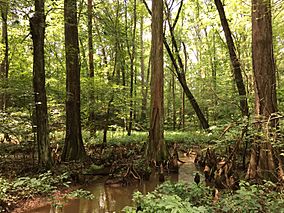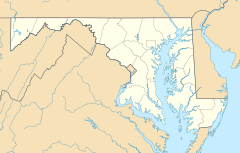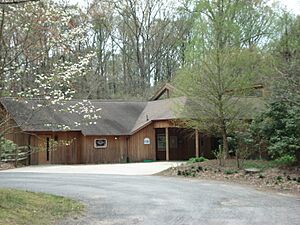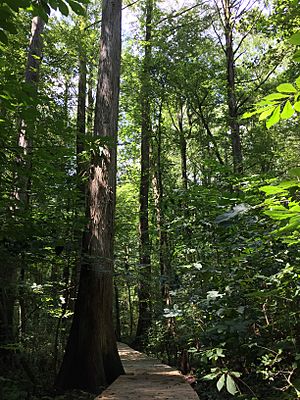Battle Creek Cypress Swamp facts for kids
Quick facts for kids Battle Creek Cypress Swamp |
|
|---|---|
 |
|
| Location | Calvert County, Maryland |
| Nearest city | Prince Frederick |
| Area | 100 acres (40 ha) |
| Established | 1957 |
| Designated: | 1965 |
The Battle Creek Cypress Swamp (BCCS) is a special forest wetland. It is located near Prince Frederick in Calvert County, Maryland, United States. This swamp is one of the most northern places where bald cypress trees grow naturally. It is also the only large group of these trees on the western side of Maryland. In 1965, the National Park Service named the BCCS a National Natural Landmark. This means it is a very important natural place.
Exploring the Cypress Swamp Sanctuary
The Nature Conservancy bought this wetland in 1957. It then became the Battle Creek Cypress Swamp Sanctuary. This was the very first nature preserve that the Conservancy owned in Maryland. The sanctuary covers about 100 acres. This is a small part of the larger Battle Creek area.
Today, part of the sanctuary is a public park. It has a nature center where you can learn about the swamp. There is also a quarter-mile long boardwalk. This boardwalk lets you walk right through the swamp without getting wet! Since 1977, Calvert County has managed the preserve as a county park.
Wildlife and Nature in the Swamp
Cypress trees, like the bald cypress, used to grow in many northern areas. Scientists believe these trees disappeared from the BCCS area a long time ago. This happened during the last Ice Age, called the Pleistocene glaciation. But as the climate got warmer, the cypress trees came back. This was about 5,000 to 10,000 years ago.
The swamp is home to many different animals and plants. You can find many kinds of songbirds here. These include the prothonotary warbler and the northern waterthrush. Many frogs also live in the swamp. Some examples are the green frog and the spring peeper.
The sanctuary also protects several types of wildflowers. You might see the bright red cardinal flower. Another interesting plant is the jack-in-the-pulpit. In early spring, skunk cabbage plants start to grow. They are some of the first plants to appear after winter.




